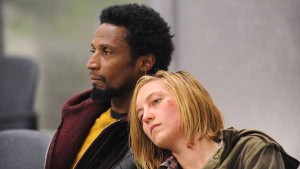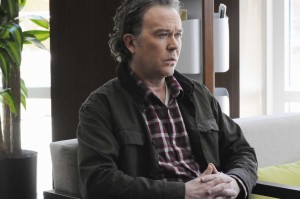
The pilot for American Crime was editor Luyen Vu’s first experience working with Oscar-winning writer and executive producer, John Ridley (12 Years a Slave), who also directed the opener. The pair met a couple of times to discuss the project and Vu was shown the feature that Ridley made right before taking on the pilot, which had an editorial style that Ridley liked.
“He liked the idea of it. He didn’t want to do the same thing over again, but he did want us to look at that and realize that there was a lot of freedom that editorial could take,” stated Vu.
During production, the editor would send the director cut scenes so Ridley could see where the edit was heading. Vu started editing in a mostly traditional manner, but unlike other shows, Ridley pushed the editors to be as risky as possible, to do things that might even be wrong.
“If we wanted to try something crazy, he wanted us to do it in our editor’s cut,” Vu explained. “Sometimes we would kind of go crazy in terms of our edit and take it too far and we’d have to pull back and rebuild it.”

A specific example of how the editing style enhanced a story point can be seen during a scene in the pilot between Hector and Bruno where Ridley described the situation as “getting f–ked-up” and then suggested to the editors “let’s get f–ked up with the editing.” Emotionally the scene conveyed a feeling of being disjointed and confused.
“So I took that and ran with it. We made a scene that is pretty untraditional by most standards, but it is interesting, because you feel more tense,” Vu said. “You are discombobulated by the process.”
Vu was aiming for “high contrast filmmaking,” meaning he wanted to create contrast between editorial styles. In the series there are scenes consisting of a single take, as long as six minutes in length. Those types of scenes would be contrasted with big, jump-cutty scenes. The specific editorial style was developed while working on the pilot, but the rules and the methodology eventually applied to all the editing on the series.
“John is an artist and his thing is to try to get as much emotional impact out of any given scene as you can. When I say there were rules, they were very soft,” said Vu. The most important consideration was whether or not the editing made the viewer feel something more. Vu added, “Did it make the tension, make the emotion, or anything better for this given scene? That ended up being our Golden Rule. We would use any technique necessary to do that.”
 Ridley felt that the edit of the pilot worked, but unfortunately it came in at over an hour, when it needed to be 42 minutes long. The original script included radio calls in between scenes that formed a commentary on what was happening.
Ridley felt that the edit of the pilot worked, but unfortunately it came in at over an hour, when it needed to be 42 minutes long. The original script included radio calls in between scenes that formed a commentary on what was happening.
“That was the first thing to go because we realized the performances were so good that we didn’t need to help the audience along,” noted Vu. “Once we cut them out we were a little bit closer. They were all good scenes, but we had to choose the best.”
Vu believes that the show was beyond lucky with the casting. Ridley looked for actors that could make it as real as possible. “Felicity Huffman and Tim Hutton were amazing. And finding a couple of newcomers has been really great,” said Vu. “All the actors were amazingly prepared. John spent a lot of time with them, discussing where he wanted them to go. He shared that with us as well. In editorial we were picking between all amazing takes. We would see what the actors would do and respond to that.”
Although the scripts for the series were generally written before Ridley moved to overseeing production, the episodic drama unfolded week by week not only for the audience, but also to some extent for the crew.
“John likes to keep a lot of things close to the chest. He wants us to be fresh to the material,” revealed Vu. “For example, for the finale which concludes this particular 11-part story line, I actually didn’t get to read the script until about two or three days into dailies. Like an audience member, I was getting these pieces of the story and trying to figure it out myself. It was an interesting way to go about it.”
Even though the editing did not directly affect the direction of the overall story, the episodes did change in postproduction, affecting how the story was told. For every episode, the editors would make cards for each scene and put them up on a wall. After cutting as scripted, they would start rearranging the order of scenes, sometimes deleting scenes, sometimes even moving a scene to another episode if it fit better into that show’s story line.
The card system also helped the editors track the progress of multiple complex character arcs, providing editorial with the structure needed to help them make choices, while remaining fluid enough to keep the emotional through-line.
“My assistant [JoAnne Yarrow] and I came up with a color and shape coded system for each story line. Sometimes we’d look at the wall and say ‘Oh my God, all of act one is blue squares.’ Sometimes that would affect us,” explained Vu. “We needed to patchwork more to have an even flow in terms of everyone’s storytelling, so we would not finish somebody’s storyline in just one act.”
“The color system was a way to design it, but as with anything else in editing, it’s all about the emotion, the flow of how you feel. Sometimes we would feel that one entire run of blue squares, which was Mark and Barb’s story line, was okay because emotionally we’re so invested that we wanted to take it to it’s conclusion.”
For Vu, the show has been the most creatively satisfying experience of his career. “We’re just hoping that we get to continue to do it,” he said.
Editor’s Note: American Crime has been nominated for Emmy awards for outstanding casting for a limited series, movie or a special, outstanding single-camera picture editing for a limited series or a movie outstanding, lead actor in a limited series or a movie, outstanding lead actress in a limited series or a movie, outstanding supporting actor in a limited series or a movie, outstanding supporting actress in a limited series or a movie, outstanding limited series, outstanding sound editing for a limited series, movie or a special, outstanding sound mixing for a limited series or a movie, and outstanding writing for a limited series, movie or a dramatic special.





